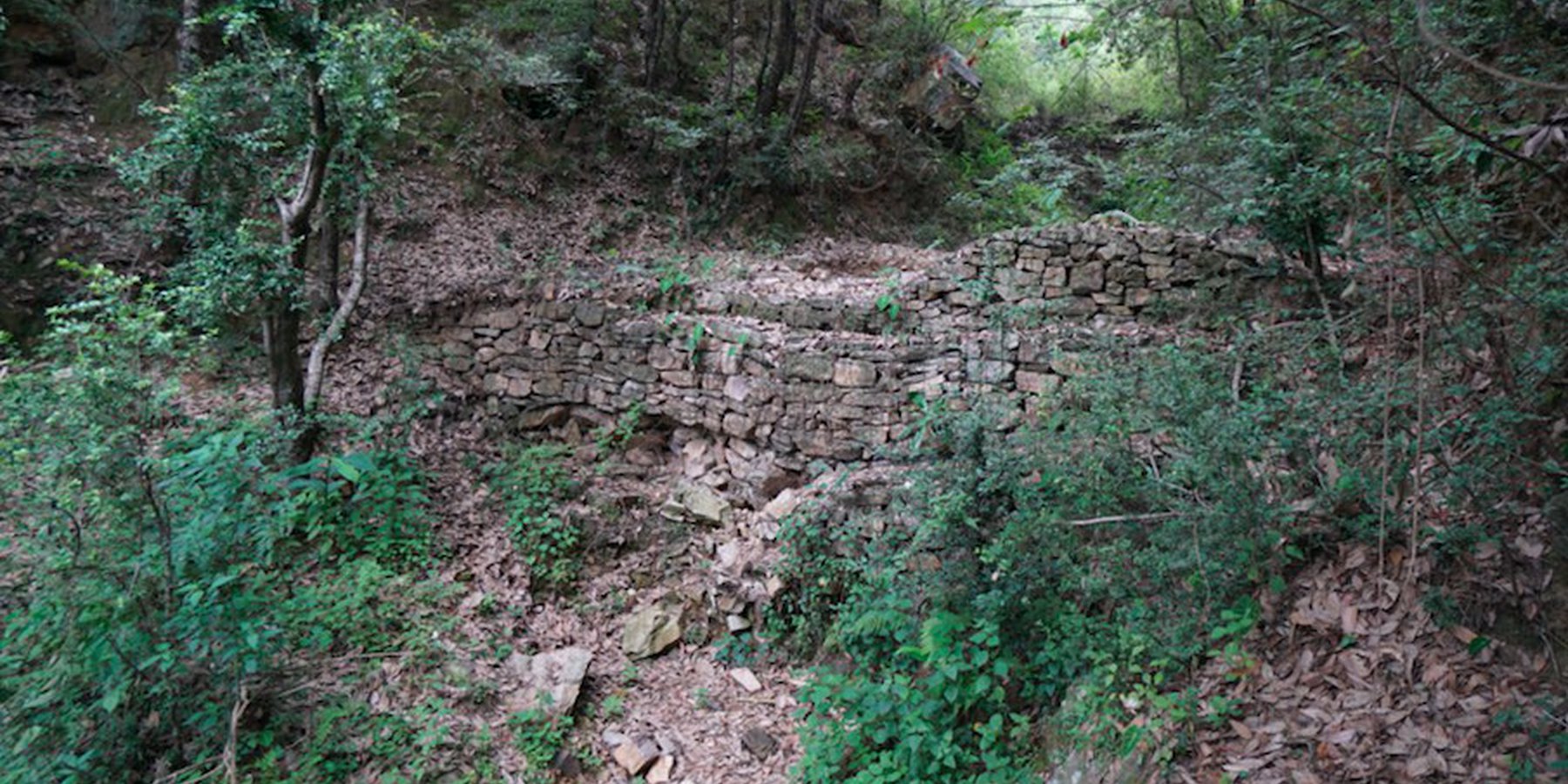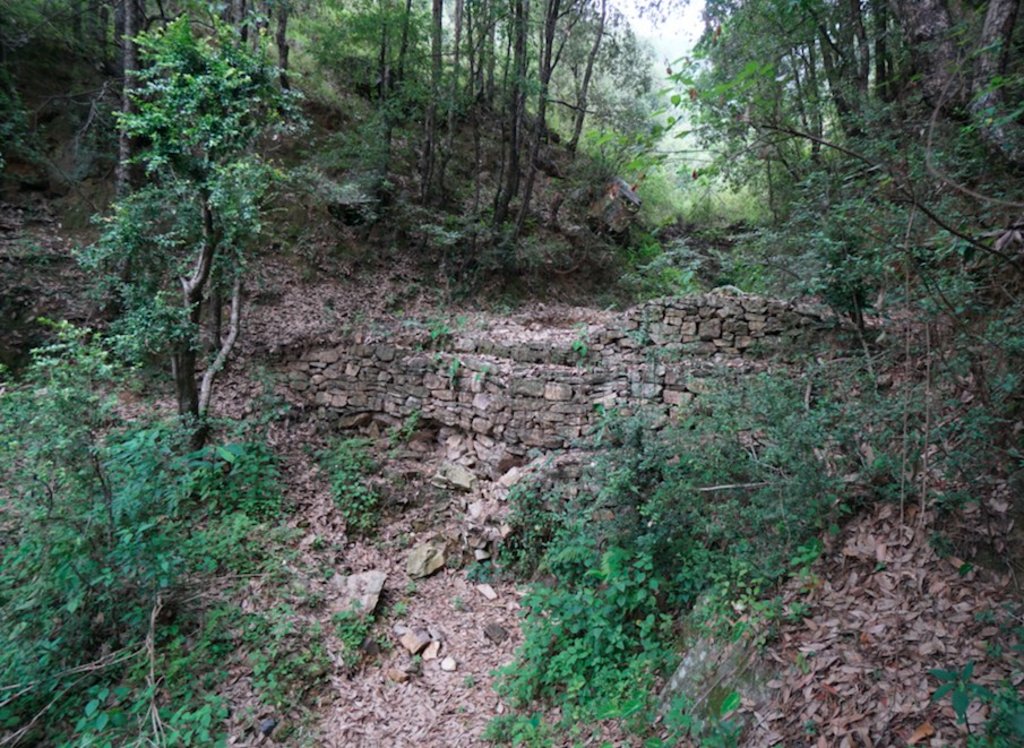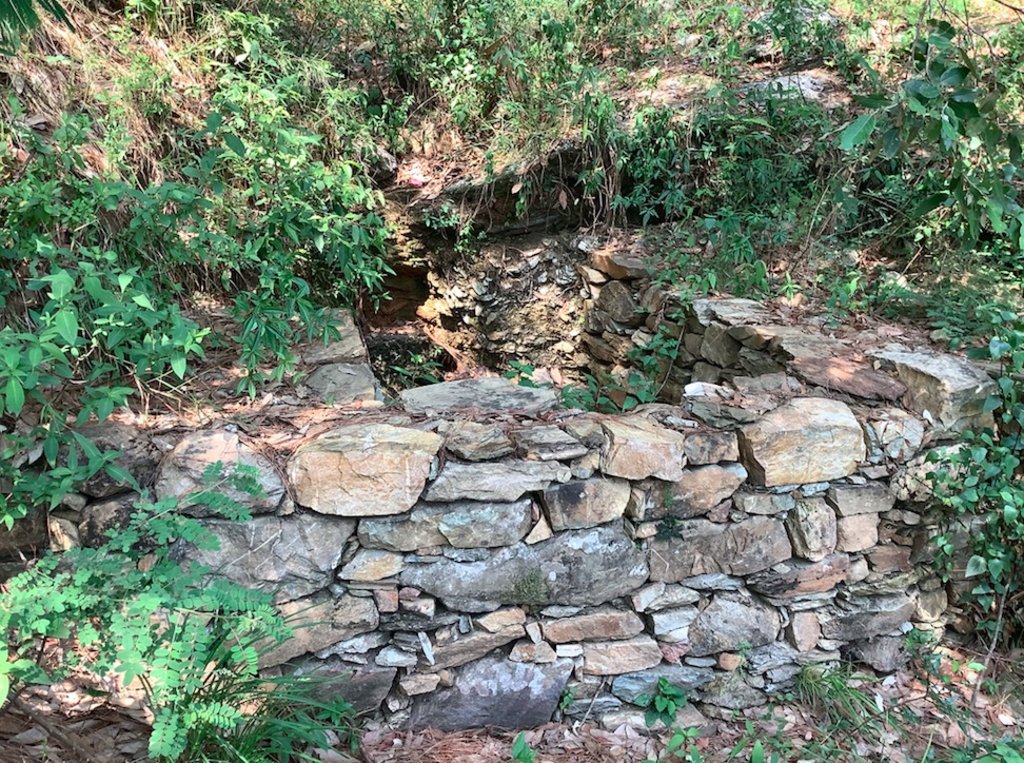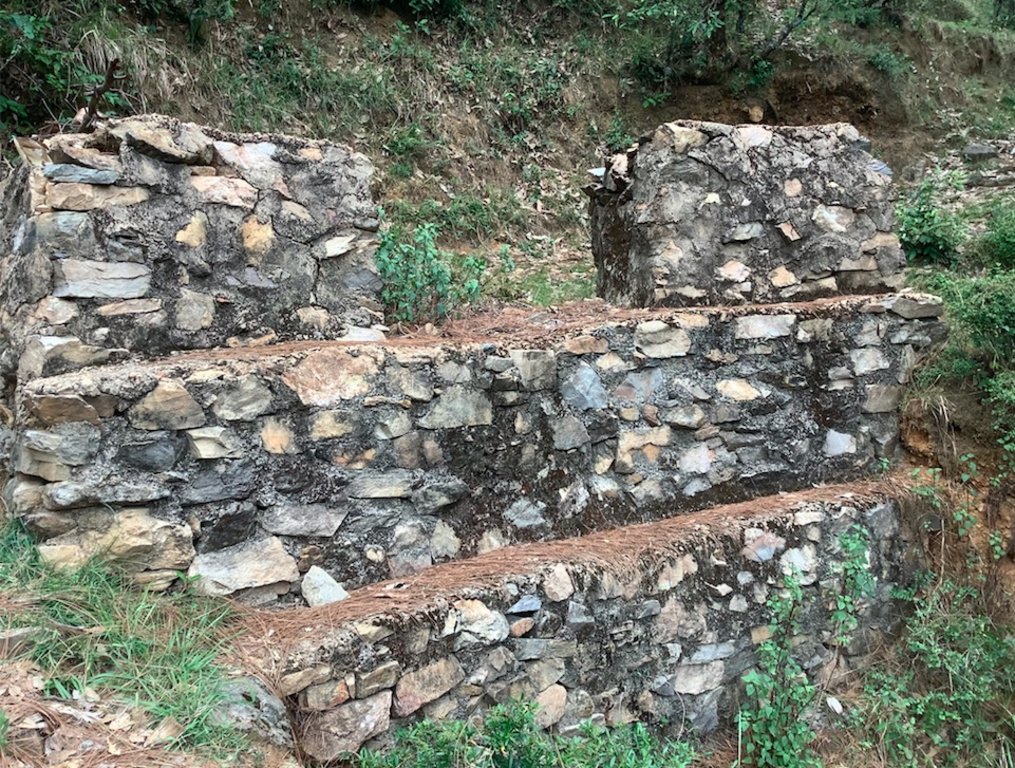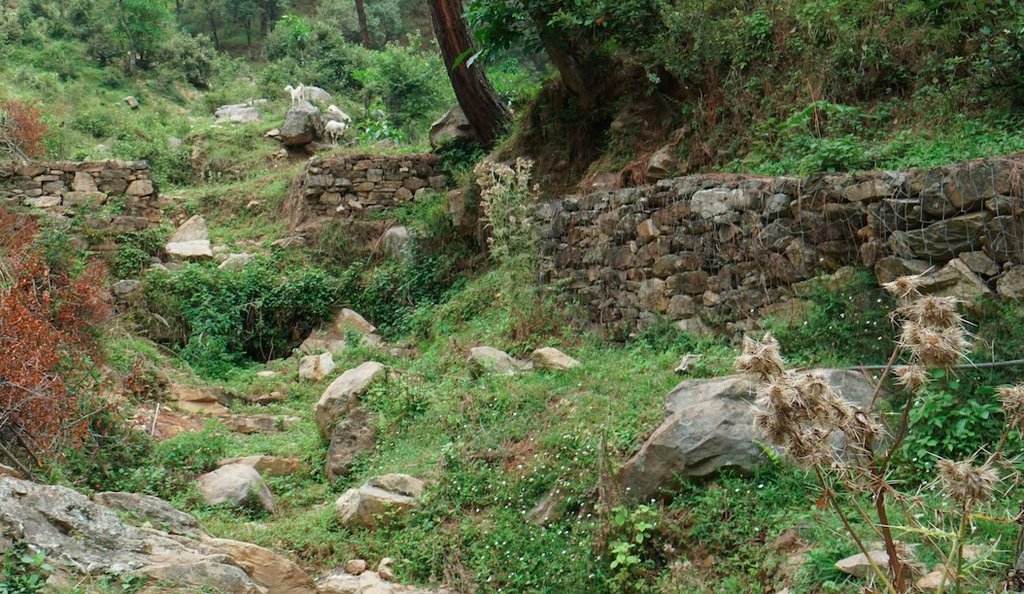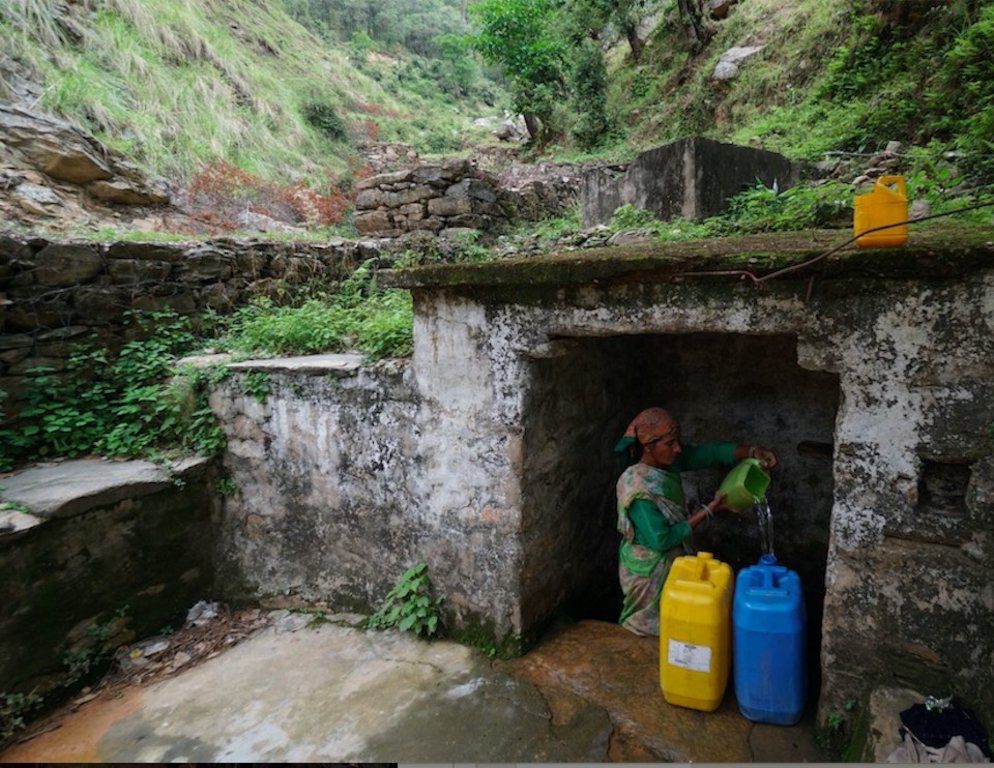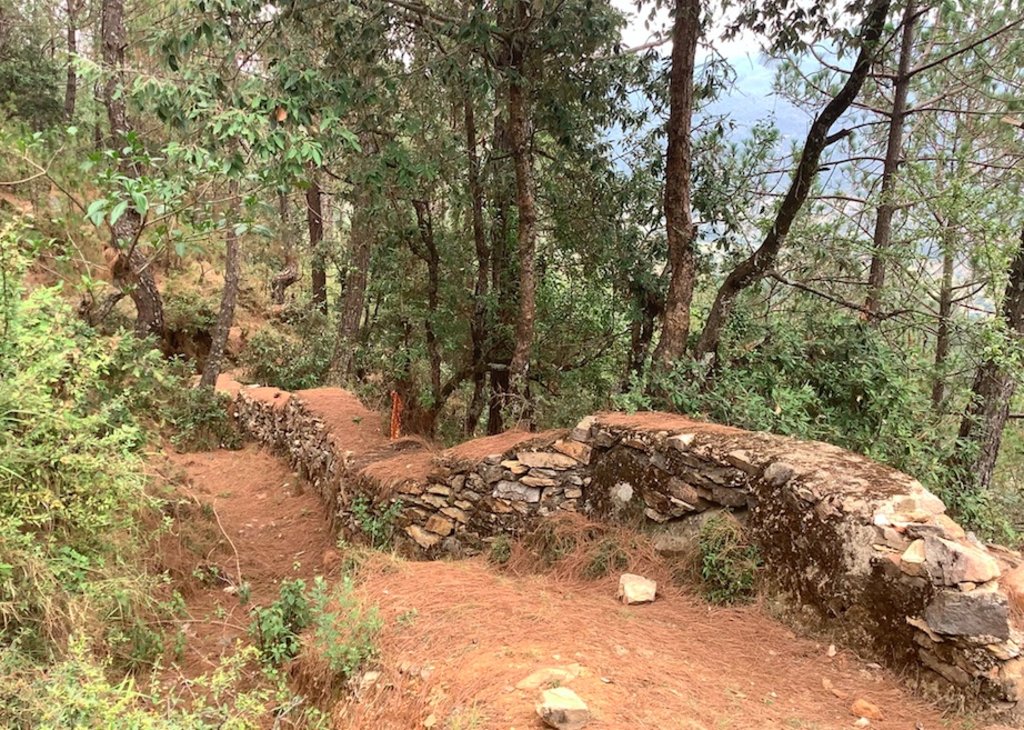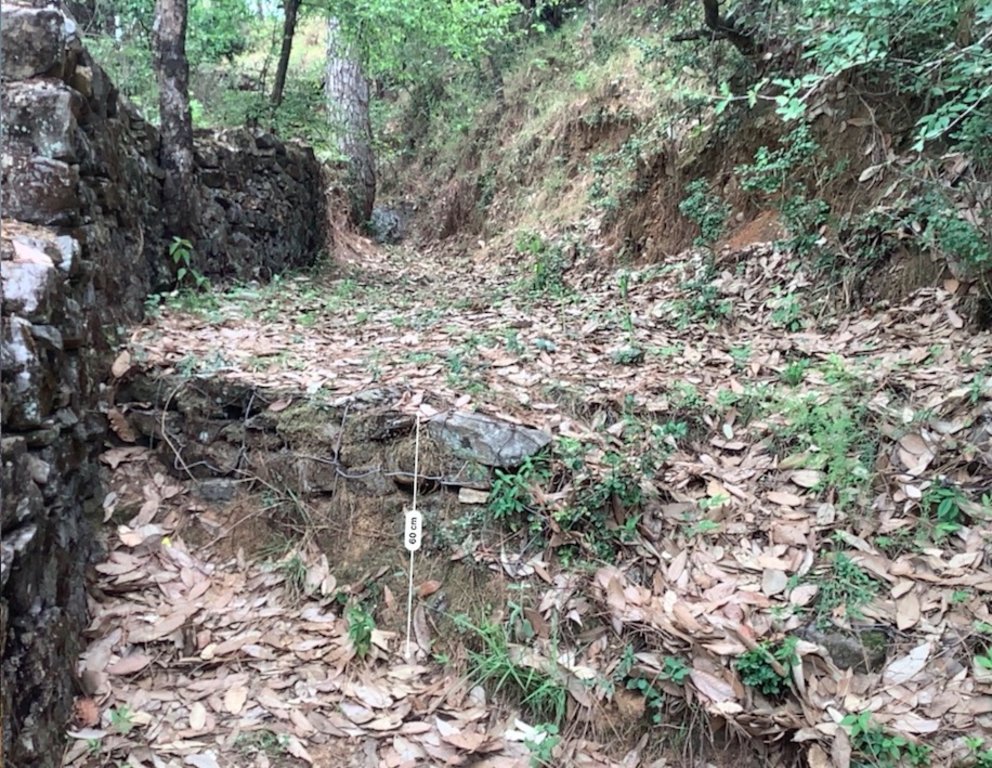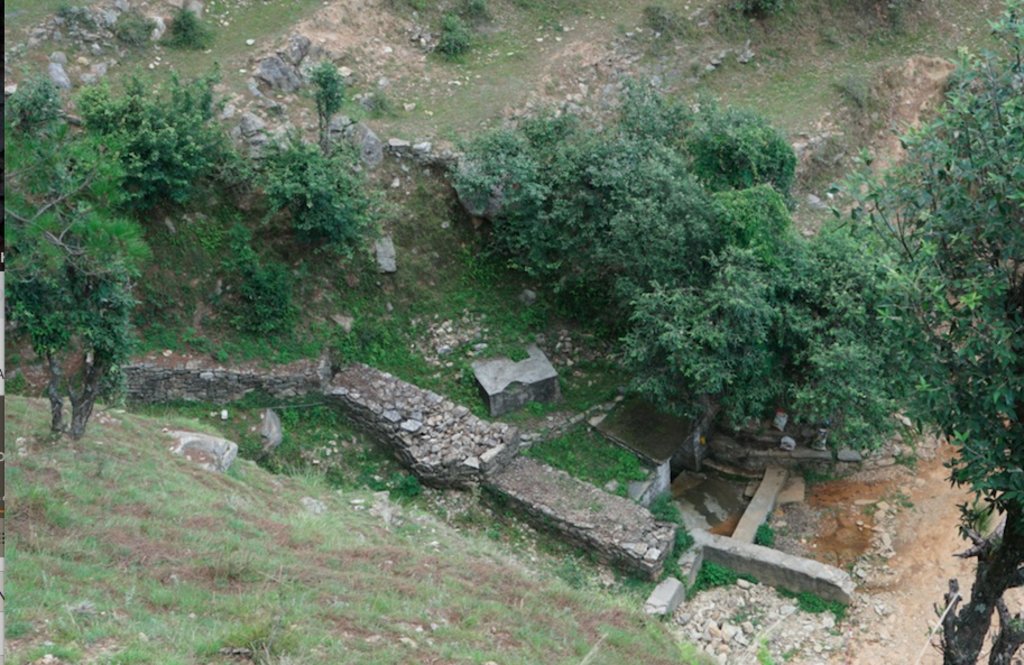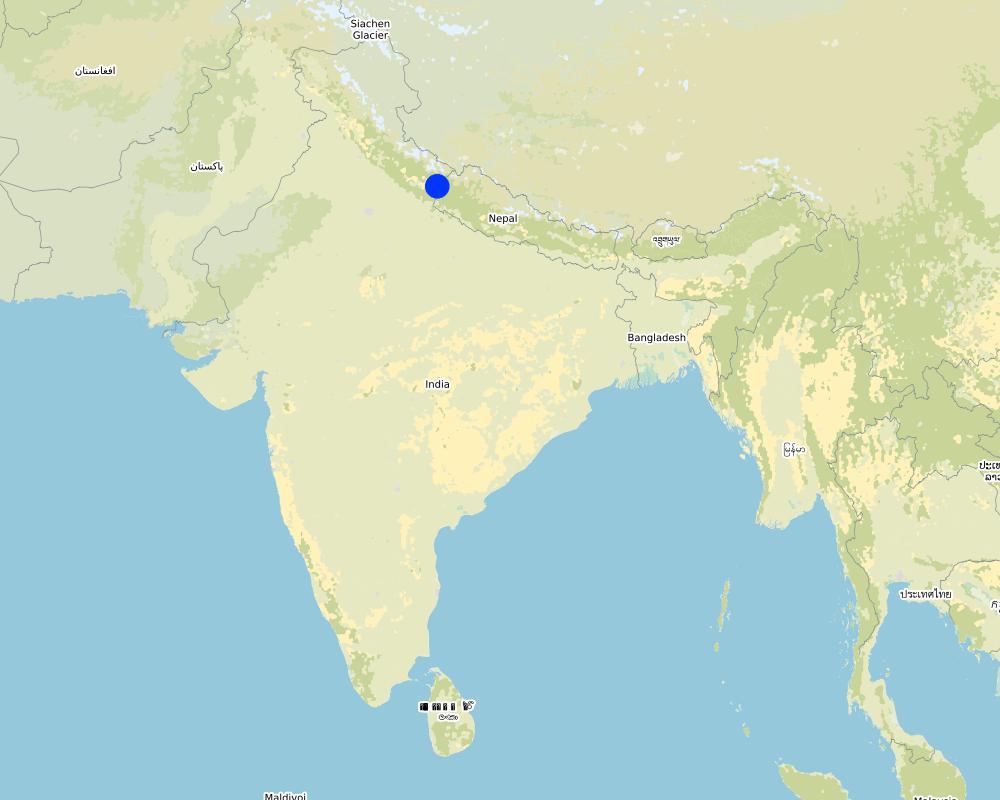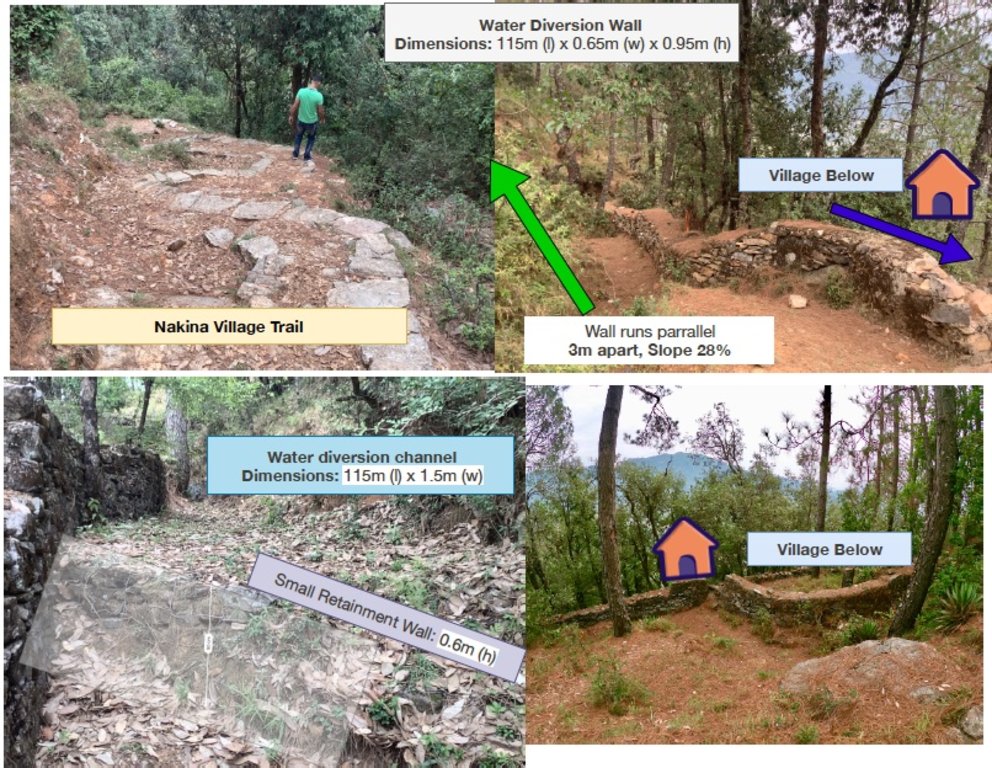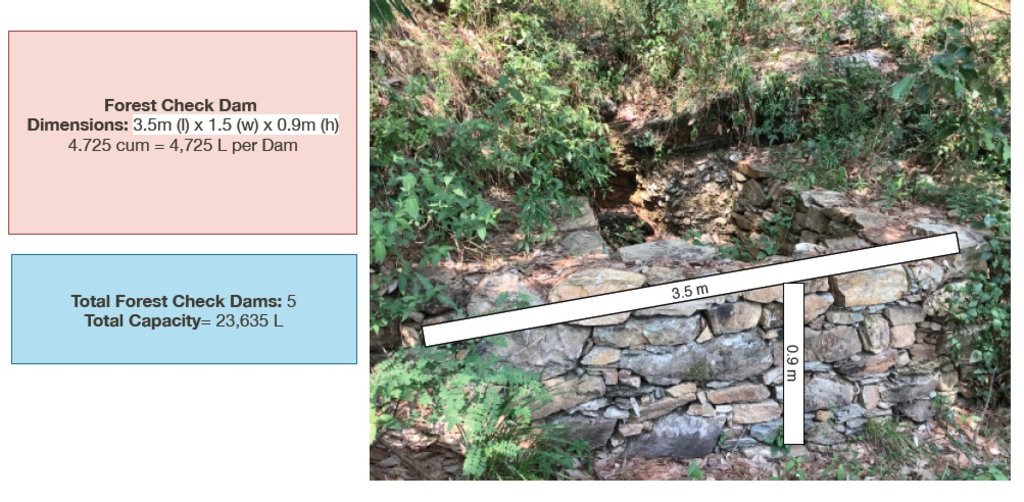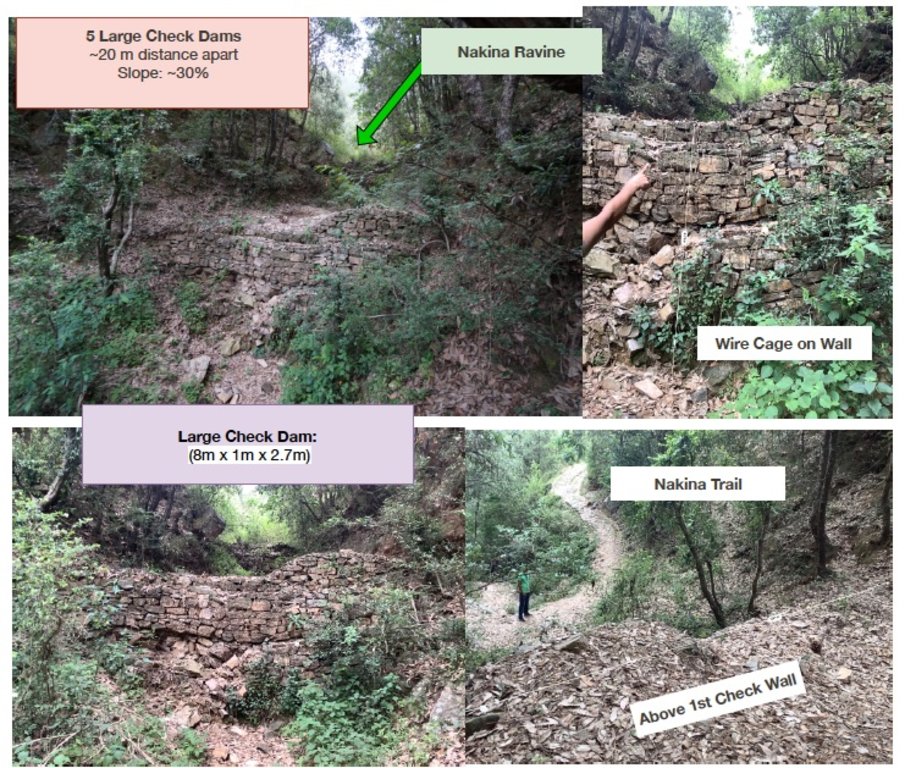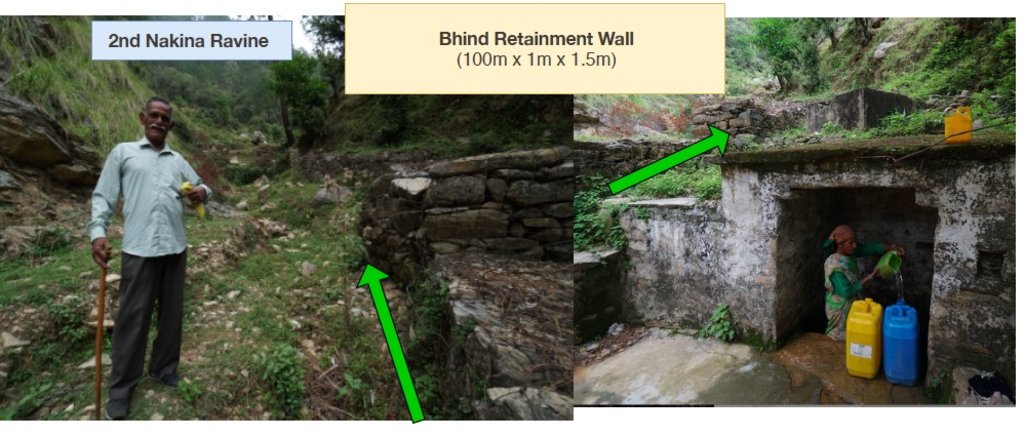Stone Check Walls and Check Dams for Soil and Water Conservation [الهند]
- تاريخ الإنشاء:
- تحديث:
- جامع المعلومات: Jaclyn Bandy
- المحرر: –
- المُراجع: Hanspeter Liniger
technologies_5210 - الهند
عرض الأقسام
توسيع الكل طي الكل1. معلومات عامة
1.2 تفاصيل الاتصال بالأشخاص الرئيسيين لمصدر المعلومات والمؤسسات المشاركة في تقييم وتوثيق التقنية
الشخص (الأشخاص) الرئيسي لمصدر المعلومات
مستخدم الأرض:
Jagdamba Joshi
Nakina Village
الهند
اسم المشروع الذي سهّل توثيق/تقييم التقنية (إذا كان ذلك على صلة)
Onsite and Offsite Benefits of SLMاسم المؤسسة (المؤسسات) التي سهلت توثيق/تقييم التقنية (إذا كان ذلك على صلة)
ICIMOD International Centre for Integrated Mountain Development (ICIMOD) - النيبالاسم المؤسسة (المؤسسات) التي سهلت توثيق/تقييم التقنية (إذا كان ذلك على صلة)
G.B. Pant Institute of Himalayan Einvironment & Development (G.B. Pant Institute of Himalayan Einvironment & Development) - الهند1.3 الشروط المتعلقة باستخدام البيانات الموثقة من خلال WOCAT
يوافق جامع المعلومات والشخص (لاشخاص) الرئيسي لمصدر المعلومات على الشروط المتعلقة باستخدام البيانات الموثقة من خلال WOCAT:
نعم
1.4 إعلان بشأن استدامة التقنية الموصوفة
هل التقنية الموصوفة هنا تمثل مشكلة فيما يتعلق بتدهور الأراضي، بحيث لا يمكن إعلانها تقنية مستدامة لإدارة الأراضي؟:
كلا
1.5 الإشارة إلى الاستبيان (الاستبيانات) حول مناهج الإدارة المستدامة للأراضي (موثقة باستخدام WOCAT)
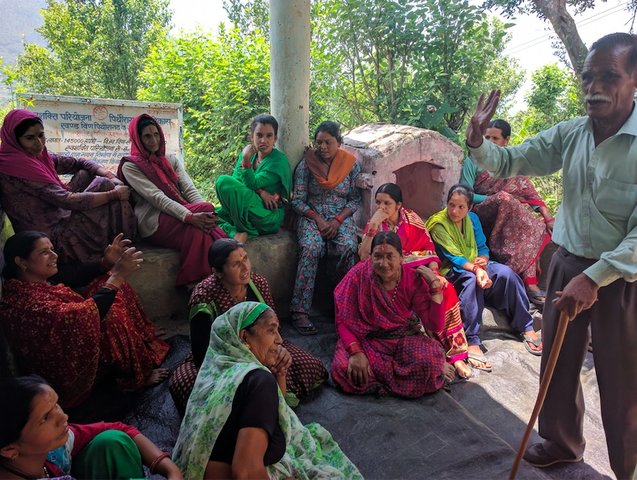
Community Forest Management in the Nakina Van Panchayat [الهند]
Van Panchayats or village forest councils are a impressive example of grassroots community management of natural resources, where a specific administrative unit is locally elected by community members who are responsible for the management of activities related to the forest.
- جامع المعلومات: Jaclyn Bandy

Naula Management and Conservation [الهند]
Naulas are shallow, four-sided stepped wells designed to collect water from subterranean seepages or springs and are used to meet domestic water needs by the local communities. Naula management and conservation encompasses a range of activities that preserve their structure and function.
- جامع المعلومات: Jaclyn Bandy
2. وصف تقنيةالإدارة المستدامي للأراضي
2.1 وصف مختصر للتقنية
تعريف التقنية:
Stone Check Dams/Walls, Retainment Walls, and a Water Diversion Wall has been constructed in Nakina Village and Nakina Community Forest to help protect their settlements, agriculture land, forest land, and preserve the hilly landscape. These structures serve to reduce the runoff velocity (lowering the rate of erosion and gullying in steep slope channels) and increase infiltration for groundwater recharge.
2.2 وصف تفصيلي للتقنية
الوصف:
1. The technology is found in both natural and human environments (forest and settlement areas)
2. Main Characteristics: A check dam or check wall is constructed in a loose or active gully or a rill (shallow channel) that threatens to enlarge, or anywhere on a slope where there is a danger of scour from running water. The structures lower the velocity of flow. In Nakina porous check walls, check dams, and retainment walls were made out of stone gathered from the surrounding area. A porous check dam releases a portion of flow through the structure, decreases the head of flow over the spillway, and decreases the dynamic and hydrostatic forces against the check dam. Porous check dams are simple and more economical for construction.
Once stones are collected they are cut into suitable sizes and surfaces ( "dressing" of stones). The site where the technology is to be constructed is then cleared and, for check dams, the sides are sloped 1:1 (this simply refers to the ratio of the rise and run of the slope, so 1:1 means you'll have a 45 degree slope for your excavation). This is also known as the angle of repose, where the granular material of the embankment will be stable and not slump from its own weight. The base of the dam should be around 70 cm thick if it is 1 meter high. The bed of gully is excavated for foundation and dry stones are packed from that level.
3. Purposes/functions: Interrupts the flow of water and flattens the gradient of a channel, thereby reducing the velocity and inducing infiltration rather than eroding the channel. These structures not only slow flow velocity but also to distribute flows across vegetation. Despite some sedimentation resulting behind the dam, small cracks and porous spaces in the holes of the stones allow some sediment to flow through and the finer particles fill the gaps and strengthen the structure. Check dams can also be designed to create small reservoirs.
4. Major activities include identifying the appropriate site of installation, collection of construction materials, technical planning of the structure dimensions and design, manual labor, and maintenance.
5. Benefits/impacts: These structures decelerate runoff and accelerates groundwater recharging by storing water and facilitating infiltration of water into the soil
6. Like/Dislike:
Advantages
•Inexpensive and relatively easy to install given local building materials and labor availability
•Reduce velocity, prevent gully erosion and cause a high proportion of the sediment load in runoff to settle out, preventing downstream damage
•When carefully located and designed, check dams can remain as permanent installations with very minor regrading
Disadvantages
•Many of these structures have a temporary nature, and need to reconstructed or removed after significant damage
•Removal or reconstruction may be a significant cost depending on the size and design
•May kill grass linings in channels if the water level remains high after rainstorms or if there is significant sedimentation.
•May create turbulence which erodes the channel banks.
•Clogging by organic material may be a problem and hinder the structure's function
2.3 صور التقنية
2.5 البلد/المنطقة/المواقع التي تم تنفيذ التقنية فيها والتي يغطيها هذا التقييم
البلد:
الهند
المنطقة/الولاية/المحافظة:
Uttarakhand
مزيد من التفاصيل حول الموقع:
Nakina Village, Pithoragarh Bloc
حدد انتشار التقنية:
- يتم تطبيقها في نقاط محددة/ تتركز على مساحة صغيرة
هل يقع موقع/مواقع التقنية في منطقة محمية بشكل دائم؟:
نعم
إذا كانت الإجابة بنعم، حدد:
5 check dams are located in the protected forest of Nakina. The other structures are located in the village settlement (the 5 check walls are within the ravine) or just above the Bhind Spring (Naula).
Map
×2.6 تاريخ التنفيذ
في حالة عدم معرفة السنة بالتحديد، يرجى الإشارة إلى التاريخ التقريبي:
- منذ أكثر من 50 عامًا (تقليدي)
2.7 إدخال التقنية
حدد كيف تم إدخال التقنية:
- من خلال ابتكار مستخدمي الأراضي
- كجزء من النظام التقليدي (> 50 عامًا)
- من خلال المشاريع/ التدخلات الخارجية
التعليقات (نوع المشروع، الخ):
Check dams and other retainment structures are technologies that have been used for centuries. Some of the structures in the village are nearly +50 years old and have either been constructed with the help of the government (ravine check dams in settlement and above Bhind Naula) and others have been more recently constructed by the villagers themselves to support the forest landscape, specifically springshed recharge.
3. تصنيف تقنية الإدارة المستدامي للأراضي
3.1 الغرض الرئيسي ( الأغراض الرئيسية) للتقنية
- الحد من تدهور الأراضي ومنعه وعكسه
- الحفاظ على النظام البيئي
- حماية مستجمعات المياه / المناطق الواقعة في اتجاه مجرى النهر - مع تقنيات أخرى
- الحد من مخاطر الكوارث
- التكيف مع تغير المناخ/الظواهر المتطرفة وآثارها
3.2 نوع (أنواع) استخدام الأراضي الحالية حيث يتم تطبيق التقنية

الغابات/ الأراضي الحرجية
- الغابات/الأراضي الحرجية (شبه) الطبيعية
الغابات/الأراضي الحرجية (شبه) الطبيعية: حدد نوع الإدارة:
- قطع الأشجار الانتقائي
نوع الغابة الطبيعية /شبه الطبيعية:
- النباتات الطبيعية في الغابات شبه الاستوائيةالجافة
- quercus leucotrichophora (Banj oak)
هل الأشجار المذكورة أعلاه ملحاء أم دائمة الخضرة؟:
- ملحاء
منتجات وخدمات:
- الخشب
- حطب الوقود
- الرعي/ رعي أطراف الأشجار الفتية (الجلح)
- حفظ/حماية الطبيعة

المستوطنات والبنية التحتية
- المستوطنات والمباني
3.3 هل تغير استخدام الأراضي نتيجة لتنفيذ التقنية؟
هل تغير استخدام الأراضي نتيجة لتنفيذ التقنية؟:
- لا (تابع مع السؤال 3.4)
3.4 إمدادات المياه
إمدادات المياه للأرض التي يتم تنفيذ التقنية عليها:
- بعلية
3.5 مجموعةالإدارة المستدامة للأراضي التي تنتمي إليها هذه التقنية
- التدابير المتقاطعة للمنحدرات
- تحويل المياه والصرف
- إدارة المياه السطحية (الينابيع، الأنهار، البحيرات، البحار)
3.6 التدابير التقنية في مجال إلادارة المستدامة للأراضي

التدابير البنيوية
- S3: الخنادق المتدرجة ،والقنوات، والممرات المائية
- S6: الجدران والحواجز وسياجات القش، والسياجات
3.7 الأنواع الرئيسية من تدهور الأراضي التي تناولتها التقنية

تآكل التربة بالمياه
- الوزن(Wt): فقدان التربة السطحية/تآكل السطح
- (Wg):الانجراف الخلجاني/ الخلجان
- (Wm): مجموعة كبيرة من الحركات الأرضية/انزلاقات أرضية
- (Wr):انجراف ضفة النهر
- (Wo:) تأثيرات التدهور من مواقع أخرى

التدهور المادي أو الفيزيائي للتربة
- (Ps): هبوط التربة العضوية، استقرار التربة

التدهور البيولوجي
- (Bc): تناقص الغطاء النباتي
- (Bq): انخفاض الكمية/الكتلة الحيوية

تدهور المياه
- (Hg): التغير في مستوى المياه الجوفية/الطبقة المائية الجوفية
3.8 منع أو حد أو عكس تدهور الأراضي
تحديد هدف التقنية فيما يتعلق بتدهور الأراضي:
- منع تدهور الأراضي
- الحد من تدهور الأراضي
4. المواصفات الفنية، وأنشطة التنفيذ، والمدخلات، والتكاليف
4.1 الرسم الفني للتقنية
4.2 معلومات عامة بخصوص حساب المدخلات والتكاليف
حدد كيفية احتساب التكاليف والمدخلات:
- لكل وحدة تقنية
حدد الوحدة:
1. Small Check Dams 2. Large Check Walls 3. Water Diversion Wall 4. Bhind Check Walls/Retainment wall
حدد أبعاد الوحدة (إذا كانت ذات صلة):
1. 5 units (3.5m x 1.5m x 0.9m) 2. 5 units (8m x 1m x 2.7m) 3. 1 unit (115m x 0.65 x 0.95m) 4. 1 unit (100m x 1m x 1.5m)
عملة أخرى/ عملة وطنية (حدد):
INR
إذا كان ذا صلة، وضح سعر الصرف من الدولار الأمريكي إلى العملة المحلية (على سبيل المثال، 1 دولار أمريكي = 79.9 ريال برازيلي): 1 دولار أمريكي =:
70,0
اذكر متوسط تكلفة أجر العمالة المستأجرة في اليوم الواحد:
400 INR per head/day
4.3 أنشطة التأسيس
| النشاط | التوقيت (الموسم) | |
|---|---|---|
| 1. | Nakina village built a long water diversion wall over +50 years ago that serves as a water channel, directing runoff away from settlements and towards the ravine | Pre-monsoon /dry season |
| 2. | Within the ravine/gully in Nakina Village, there is a series of 5 large check walls that were established with the help of the Forest Department | Pre-monsoon /dry season |
| 3. | There is a series of check walls/check dams in another gully that were established in 1952 above the Bhind Spring/Naula (on the opposite side of the village) to protect it and decrease runoff/further erosion | Pre-monsoon/dry season |
| 4. | In December 2017 the Nakina Van Panchayat (community forest council) decided to construct 5 new check dams within the Nakina Forest, which lie in the upper catchment area of the Bhind Spring | Pre-monsoon/dry season |
| 5. | For the establishment of all these structures, the community and technical assistants assessed the topography of the area, size of the gully, catchment area and runoff rate before establishing the check-dam. | Pre-monsoon/dry season |
| 6. | The sites were selected and prepared by removing debris and other unsuitable material which would interfere with proper placement of the check dam/wall materials. | Pre-monsoon/dry season |
4.4 التكاليف والمدخلات اللازمة للتأسيس
| تحديد المدخلات | الوحدة | الكمية | التكاليف لكل وحدة | إجمالي التكاليف لكل مدخل | % من التكاليف التي يتحملها مستخدمو الأراضي | |
|---|---|---|---|---|---|---|
| العمالة | Large Water Diversion Wall | person-days | 60,0 | 400,0 | 24000,0 | 20,0 |
| العمالة | 5 Large Check Walls | person-days | 50,0 | 400,0 | 20000,0 | 20,0 |
| العمالة | Bhind Spring Check Walls/Retainment Wall | person-days | 19,0 | 400,0 | 7600,0 | 50,0 |
| العمالة | 5 Small Check Walls in Forest | person-days | 10,0 | 400,0 | 4000,0 | 100,0 |
| معدات | Crate Wire (15m x 2m x 2m) | Cum | 60,0 | 75,0 | 4500,0 | |
| معدات | Pick | pieces | 15,0 | 300,0 | 4500,0 | 100,0 |
| معدات | Shovel | pieces | 20,0 | 500,0 | 10000,0 | 100,0 |
| معدات | pharuwa (hoe) | pieces | 15,0 | 300,0 | 4500,0 | 100,0 |
| معدات | khanti (digging bar) | pieces | 10,0 | 1500,0 | 15000,0 | 100,0 |
| معدات | hammer (5kg) | pieces | 10,0 | 2000,0 | 20000,0 | 100,0 |
| معدات | chino (chisel) | pieces | 10,0 | 500,0 | 5000,0 | 100,0 |
| معدات | khukuri (knife) | pieces | 10,0 | 250,0 | 2500,0 | 100,0 |
| المواد النباتية | small hammer (0.5-1 kg) | pieces | 15,0 | 300,0 | 4500,0 | 100,0 |
| مواد البناء | Rocks of various size and shape collected/excavated on site | |||||
| مواد البناء | Small Check Walls in Forest (5) | cum | 23,625 | 200,0 | 4725,0 | 100,0 |
| مواد البناء | Large Check Walls (5) | cum | 108,0 | 200,0 | 21600,0 | 20,0 |
| مواد البناء | Large Water Diversion Wall (1) | cum | 71,0 | 200,0 | 14200,0 | 100,0 |
| مواد البناء | Bhind Check Walls/Retainment Wall (5) | cum | 150,0 | 200,0 | 30000,0 | 50,0 |
| غير ذلك | Rocks of various size and shape collected/excavated on site | |||||
| إجمالي تكاليف إنشاء التقنية | 196625,0 | |||||
| إجمالي تكاليف إنشاء التقنية بالدولار الأمريكي | 2808,93 | |||||
إذا تحمل مستخدم الأرض أقل من 100% من التكاليف، حدد من قام بتغطية التكاليف المتبقية:
Uttarakhand Forest Department (Government), JICA (Japan International Cooperation Agency)
التعليقات:
Cost Estimate: 200 INR/cum
Example:
1. Small Check Dams: 5 units (3.5m x 1.5m x 0.9m) ----- 4.725 cum x 200 INR = 945 INR/unit
945 INR/unit x 5 units = 4,725 Rs
or...
(4.725 cum/unit x 5 unit = 23.625 total cum )
(23.625 total cum x 200 INR = 4,725 Rs.)
2. Large Check Walls: 5 units (8m x 1m x 2.7m) -----21.6 x 200 = 4320
4320 cum x 5 units = 21,600 Rs
3. Water Diversion Wall: 1 unit (115m x 0.65 x 0.95m) ------71 x 200= 14,200
14,200 X 1 unit= 14,200 Rs
3. Bhind Spring Check Walls/Retainment Wall: 1 unit (100m x 1m x 1.5m) = 150 total cum
150 x 200 INR = 30,000 INR Total
4.5 الصيانة/الأنشطة المتكررة
| النشاط | التوقيت/الوتيرة | |
|---|---|---|
| 1. | Inspection of the check dam for rock displacement and erosion around the ends of the dam after each significant rainfall event | Monsoon/ weekly |
| 2. | Sediment accumulation is removed if it reaches a depth of ½ the original dam height | Pre-monsoon/Monsoon |
| 3. | Sometimes check dams are removed when their useful life is completed | Annual inspections |
4.6 التكاليف والمدخلات اللازمة للصيانة/للأنشطة المتكررة (سنويًا)
| تحديد المدخلات | الوحدة | الكمية | التكاليف لكل وحدة | إجمالي التكاليف لكل مدخل | % من التكاليف التي يتحملها مستخدمو الأراضي | |
|---|---|---|---|---|---|---|
| العمالة | Reconstruction of damaged check dams | person-days/unit | 10,0 | 400,0 | 4000,0 | 100,0 |
| العمالة | Removal of sediment | person-days/unit | 5,0 | 400,0 | 2000,0 | 100,0 |
| معدات | pick | pieces | 3,0 | 70,0 | 210,0 | 100,0 |
| معدات | shovel | pieces | 3,0 | 42,0 | 126,0 | 100,0 |
| معدات | pharuwa (hoe) | pieces | 2,0 | 52,0 | 104,0 | 100,0 |
| معدات | khanti (digging bar) | pieces | 2,0 | 30,0 | 60,0 | 100,0 |
| معدات | hammer | pieces | 3,0 | 25,0 | 75,0 | 100,0 |
| معدات | chino (chisel) | pieces | 2,0 | 75,0 | 150,0 | 100,0 |
| معدات | khukuri (knife) | pieces | 2,0 | 22,0 | 44,0 | 100,0 |
| معدات | small hammer (0.5-1kg) | pieces | 3,0 | 120,0 | 360,0 | 100,0 |
| مواد البناء | Stones available at site locally | |||||
| إجمالي تكاليف صيانة التقنية | 7129,0 | |||||
| إجمالي تكاليف صيانة التقنية بالدولار الأمريكي | 101,84 | |||||
4.7 أهم العوامل المؤثرة على التكاليف
قدم وصفا لأهم العوامل التي تؤثر على التكاليف:
Size of the check dam/check wall
Frequency and intensity of the damage to the structures
Labor availability
5. البيئة الطبيعية والبشرية
5.1 المناخ
هطول الأمطار السنوي
- < 250 مم
- 251- 500 ملم
- 501 - 750ملم
- 1,000-751 ملم
- 1,500-1,100 ملم
- 2,000-1,500 ملم
- 3,000-2,001 ملم
- 4,000-3,100 ملم
- > 4000 ملم
حدد متوسط هطول الأمطار السنوي (إذا كان معروفًا)، بالملليمتر:
1500,00
المواصفات/التعليقات على هطول الأمطار:
Monsoon- mid-June to mid-September; July and August are the rainiest months and the temperature is warm and moist; between 70-85% of the annual precipitation occurs in the monsoon season
Seasons
a. Winter or Cold weather (mid Dec. - mid March)
b. Summer or hot weather (mid March - mid June)
c. Season of general rains (South - West monsoon season)
d. Season of retreating monsoon (mid September to mid November)
الإشارة إلى اسم محطة الأرصاد الجوية المرجعية المعنية:
India Meteorological Department, Meteorological Centre Dehradun
المنطقة المناخية الزراعية
- شبه رطبة
The overall climatic condition in the Pithoragarh district is governed by the southwest monsoon. It has a sub-tropical to temperate climate, with three pronounced seasons; summer, winter, and monsoon. The hilly terrain of the Himalayan region has snow cover and is cold during winter with snowfall normally occurring during the months of December to March.
Temperature- The temperature ranges from 0°C to 10°C in winter and from 8°C to 33°C in summer season. However, there is no meteorological observatory in the district. The account of the climate is based mainly on the records of the observations in the neighboring districts where similar meteorological conditions prevail. Variations in temperature are considerable from place to place and depend upon elevation as well as aspect. As the insolation is intense at high altitudes, in summer temperatures are considerably higher in the open than in the shade.
5.2 طوبوغرافيا
متوسط الانحدارات:
- مسطح (0-2%)
- بسيط (3-5%)
- معتدل (6-10%)
- متدحرج (11-15%)
- تلال (16-30%)
- شديدة الانحدار(31-60%)
- فائقة الانحدار (>60%)
التضاريس:
- هضاب/سهول
- أثلام مرتفعة
- المنحدرات الجبلية
- منحدرات التلال
- منحدرات في السفوح
- قاع الوادي
المنطقة الارتفاعية:
- 100-0 متر فوق سطح البحر
- 500-101 متر فوق سطح البحر
- 1,000-501 متر فوق سطح البحر
- 1,500-1,001 متر فوق سطح البحر
- 2,000-1,501 متر فوق سطح البحر
- 2,500-2,100 متر فوق سطح البحر
- 3,000-2,501 متر فوق سطح البحر
- 4,000-3,001 متر فوق سطح البحر
- > 4000 متر فوق سطح البحر
وضح ما إذا كانت التقنية مطبقة على وجه التحديد في:
- حالات مقعرة
التعليقات والمواصفات الإضافية بشأن التضاريس:
Altitude of evaluated sites: 1800-1990m
Average Slope: 25-+30%
5.3 التربة
متوسط عمق التربة:
- ضحل جدًا (0-20 سم)
- ضحلة (21-50 سم)
- متوسطة العمق (51-80 سم)
- عميقة (81-120 سم)
- عميقة جدًا (> 120 سم)
قوام التربة (التربة السطحية):
- خشن / خفيف (رملي)
- متوسط ( طميي، سلتي)
قوام التربة (> 20 سم تحت السطح):
- متوسط ( طميي، سلتي)
المواد العضوية في التربة السطحية:
- متوسطة (1-3%)
- منخفضة (<1%)
إذا كان متاحًا، قم بإرفاق وصف كامل للتربة أو تحديد المعلومات المتوفرة، على سبيل المثال نوع التربة، الرقم الهيدروجيني/ درجة حموضة التربة، قدرة التبادل الكاتيوني، النيتروجين، الملوحة وما إلى ذلك.
Mountain/hill soils are a collective name given to various types of soils found under the following conditions :
-under sub-tropical, temperate and sub-alpine conditions
-under various forest types
Characteristics: very thin, fertile, and may be less than a centimeter deep on steep slopes; they are mixed with pebbles, shingles (a mass of small rounded pebbles), and gravels; they have a low-medium water holding capacity. Angular and subangular fragments of parent rock may be found mixed with the lower layers of the mountain and hill soils.
Texture: varies from loamy to sandy loam.
Soil Reaction: ranges from acidic to neutral (pH 4.6 to 6.5)
Organic Matter content: 1-5%
Ferrugenous red roils are found in this district and are well developed over Himalayan rocks (quartzite, biotite schist, amphibolite schist). They are free of carbonates and deficient in nitrogen, humus and phosphorus, light textured, porous, and friable (brittle/crumbly). The soil depth ranges from about 10cm-75 cm. These soils may be grouped into two on basis of morphology
1. Red earths- loose, friable topsoil rich in secondary concretions (hard, compact mass of matter formed by the precipitation of mineral cement within the spaces between particles, and is found in sedimentary rock or soil)
2. Red loam- argillaceous soils having a blocky structure (argillaceous minerals may appear silvery upon optical reflection and are minerals containing substantial amounts of clay-like components, e.g. argillaceous limestones are limestones consisting predominantly of calcium carbonate, but including 10-40% of clay minerals)
Brown soil: is found particularly under dense broadleaved temperate and sub-alpine forests. There occurs a thick layer of humus on the forest floor (made of decomposed leaves, branches, twigs) and the topsoil is extremely rich in humus
Podsolic Soil: soil that has developed in humid/temperate conditions usually under coniferous forests (e.g. deodar, blue pine, fir, spruce) over quartzite, granites, schists and gneiss.
Citation: Kumaun: The Land and the People, Sharad Singh Negi (1993)
5.4 توافر المياه ونوعيتها
منسوب المياه الجوفية:
> 50 م
توافر المياه السطحية:
متوسط
نوعية المياه (غير المعالجة):
مياه شرب جيدة
تشير جودة المياه إلى:
المياه الجوفية
هل تعتبر ملوحة الماء مشكلة؟:
كلا
هل تحدث فيضانات في المنطقة؟:
كلا
تعليقات ومواصفات أخرى بشأن نوعية المياه وكميتها:
Quantity: Water crisis has been a perennial problem in both the rural and urban areas of the Pithoragarh district
There is scarcity of safe drinking water of the villages in the study area. Hand pumps are often not functioning, pipe-water schemes are unreliable and the spring discharges have reduced during the dry season. Hand-pumped water often has a high iron content and bitter taste. Poor quality of groundwater in some of the naulas is mainly due to misuse and/or disuse of the structures.
A block-district groundwater resource estimation could not be carried out as the area is hilly (with slope >20%) and in major part aquifers are small, isolated bodies, and groundwater abstraction is done mainly through hand pumps and springs with small discharges.
However, we collected some physicochemical parameters that indicate the water (sourced from springs) is of good quality:
Water Quality Parameters of Springs:
pH: 6.29-8.18
Temp: 19.0-23.5 ºC
Electrical Conductivity: 109-504 µmsiemens
Total Dissolved Solids: 75-385 ppm
Other Parameters (from springs of nearby district, Champawat)
Electrical Conductivity: 127-222 µmsiemens
pH: 7.69-8.24
Calcium: 16-36 mg/l
Magnesium: 4.9-7.3 mg/l
Bicarbonate: 61-134 mg/l
Chloride: 5.3- 8.9 mg/l
Total Hardness as CaCO3: 70-110 mg/l
Source: Government of India Ministry of Water Resources, Central Ground Water Board, 2009 Groundwater Brochure of Champawat District (2009)
5.5 التنوع البيولوجي
تنوع الأنواع:
- متوسط
تنوع الموائل:
- متوسط
التعليقات والمواصفات الإضافية بشأن التنوع البيولوجي:
Uttarakhand has more than 7000 species of medicinal plants and 500 species of fauna. Floral diversity contributes 31% of total floral density of India. Fauna contributes just 1.58% of the total faunal density of the country. There are 119 endemic species of flowering plants in the state that exhibited 2.35% endemism and 35 faunal endemic species. Because it lies at the juncture of India, Nepal and the Tibeten Autononmous region, there often cases of poaching and smuggling of wildlife contrabands, including bear bile, musk pods and leopard skins through the borders. Yarsa Gumba Ophiocordyceps sinensis, commonly known as Caterpillar Fungus, is also illegally traded transboundary in the region, together with various plant species. Due to anthropogenic impacts, changes is soil quality, and climatic elements, the biodiversity of our study site is not as high as in other areas of the Pithoragarh district.
Citation: Sundriyal, M. & Sharma, B. (2016). Status of Biodiversity in Central Himalaya, Applied Ecology and Environmental Sciences, 4( 2), 37-43.
5.6 خصائص مستخدمي الأراضي الذين يطبقون التقنية
مستقر أو مرتحل:
- غير المترحل
التوجه السوقي لنظام الإنتاج:
- الكفاف (الإمداد الذاتي)
- مختلط (كفاف/ تجاري)
الدخل من خارج المزرعة:
- 10-50% من جميع الإيرادات
المستوى النسبي للثروة:
- ضعيف
أفراداً أو مجموعات:
- المجموعات/ المجتمع المحلي
مستوى المكننة:
- عمل يدوي
الجنس:
- نساء
- رجال
عمر مستخدمي الأرضي:
- شباب
- متوسط العمر
- كبار السن
اذكر الخصائص الأخرى ذات الصلة لمستخدمي الأراضي:
With recent development in Pithoragarh, an influx of funds coming from outside sources has caused a decline in the importance of agriculture production, which in now marginalized, based on female labour, and mainly conducted for subsistence with little surplus to sell. High caste men do not work in cultivation at all, and male tasks such as ploughing are performed by the Scheduled Caste.
Although most women are still cultivating, their work has lost economic importance. For most families, the produce does not cover the needs of the household and surplus must be bought from the market. Many of the terraces that were formerly fruit orchards (mainly citrus) have been completely abandoned. Farming is less intensive and landholdings are small and fragmented. The main crops are wheat, millet, and pulses, but yields are low as the land is not irrigated. Less livestock (cows, goats, buffalo) is kept because of the labor involved. Very little capital is returned to farming. Crops produced for the markets in the plains are replacing traditional crops to sustain the household.
With exposure to the“Modern” lifestyle, new values have also been accepted. Two children are the norm (the ideal being one son and one daughter, but at least one son in a must). Although access to education is quite good, it does not seem to result in working careers for women. The women, both young and old, spend their days with domestic and agriculture work. Several village persons stated that it would be best to educate their daughters so they could get a government job.
5.7 متوسط مساحة الأرض التي يستخدمها مستخدمو الأراضي الذين يطبقون التقنية
- < 0.5 هكتارا
- 0.5 - 1 هكتار
- 1 -2 هكتار
- 2 - 5 هكتار
- 5 - 15 هكتار
- 15 - 50 هكتار
- 50 - 100هكتار
- 500-100 هكتار
- 1,000-500 هكتار
- 10,000-1,000 هكتار
- > 10,000 هكتار
هل يعتبر هذا نطاقًا صغيرًا أو متوسطًا أو واسعا (في إشارة إلى السياق المحلي)؟:
- على نطاق صغير
5.8 ملكية الأراضي، وحقوق استخدام الأراضي، وحقوق استخدام المياه
ملكية الارض:
- مجتمعي/قروي
حقوق استخدام الأراضي:
- مجتمعي (منظم)
حقوق استخدام المياه:
- وصول مفتوح (غير منظم)
- مجتمعي (منظم)
هل تعتمد حقوق استخدام الأراضي على نظام قانوني تقليدي؟:
نعم
حدد:
Under the Kumaun Panchayat forest rules of 1931 (amended in 1976): A Van Panchayat, (community forest council), can be formed out of non-private land within the settlement boundaries of a village. Accordingly, all villagers are members of the VP upon their approval by a Sub-Divisional Magistrate under the state Revenue Department. The members are collectively referred to as the general body, which selects the management committee members through a democratic process.
التعليقات:
5-9 elected members assume control and regulation of forest resources. They additionally raise funds and mobilize the village to protect and support sustainable land use.
5.9 الوصول إلى الخدمات والبنية التحتية
الصحة:
- ضعيف
- معتدل
- جيد
التعليم:
- ضعيف
- معتدل
- جيد
المساعدة التقنية:
- ضعيف
- معتدل
- جيد
العمل (على سبيل المثال خارج المزرعة):
- ضعيف
- معتدل
- جيد
الأسواق:
- ضعيف
- معتدل
- جيد
الطاقة:
- ضعيف
- معتدل
- جيد
الطرق والنقل:
- ضعيف
- معتدل
- جيد
مياه الشرب وخدمات الصرف الصحي:
- ضعيف
- معتدل
- جيد
الخدمات المالية:
- ضعيف
- معتدل
- جيد
التعليقات:
The situation of infrastructure is difficult and inconsistent in the hill regions because of the terrain. The major infrastructural issues are drinking water and irrigation facilities, electricity, transportation and communication facilities and social infrastructure (housing and education). As for financial services, only the State Bank of India (SBI) is active in the hill regions where it is trying to achieve the objective of 100% financial inclusion. Some villages mentioned buying into into agricultural insurance in the past, however this was a temporary enterprise and they were never compensated after extreme climatic events that occurred and damaged over 70% of their crop.
Though infrastructure and education has generally improved over the years, institutional and marketing networks in the region aimed at supporting hill-farmers are lacking.
6. الآثار والتصريحات الختامية
6.1 الآثار التي أظهرتها التقنية في الموقع
الآثار الاجتماعية والاقتصادية
الإنتاج
جودة الغابات/الأراضي الحرجية
إدارة الأراضي
التعليقات/ حدد:
The check dams helped deter the damage from runoff to their settlements and conserved the forest trail that is commonly used to access the areas where fodder/grass collection is permitted.
الآثار الاجتماعية والثقافية
المعرفة بالإدارة المستدامة للأراضي/تدهور الأراضي
التعليقات/ حدد:
People have seen the benefits of constructing these structures, and they continue to participate in maintaining and building more check dams to reduce erosion and increase groundwater recharge.
الآثار الايكولوجية
دورة المياه / الجريان السطحي
كمية المياه
حصاد / جمع المياه
الجريان السطحي
تصريف المياه الزائدة
مستوى المياه الجوفية/ الطبقة المائية الجوفية
التبخر
التربة
رطوبة التربة
غطاء التربة
فقدان التربة
تراكم التربة
تكون قشرة التربة السطحية/انسداد مسام التربة
تراص التربة
دورة المغذيات/إعادة الشحن
التنوع البيولوجي: الغطاء النباتي، الحيوانات
الغطاء النباتي
الكتلة الحيوية/ طبقة الكربون فوق التربة
الحد من مخاطر المناخ والكوارث
انزلاقات أرضية / تدفقات الحطام
آثار الجفاف
آثار السيكلون والعواصف المطرية
خطر الحريق
المناخ الموضعي (مايكرو)
6.2 الآثار التي أظهرتها التقنية خارج الموقع
توافر المياه
تدفقات مائية موثوقة ومستقرة في موسم الجفاف
تراكم الطمي باتجاه مصب النهر
القدرة على التخفيف / الترشيح
الأضرار التي لحقت بحقول الجيران
الضرر على البنية التحتية العامة/ الخاصة
6.3 تعرض التقنية وحساسيتها لتغير المناخ التدريجي والظواهر المتطرفة/الكوارث المرتبطة بالمناخ (كما يراها مستخدمو الأراضي)
تغير مناخ تدريجي
تغير مناخ تدريجي
| الموسم | زيادة أو نقصان | كيف تتعامل التقنية مع ذلك؟ | |
|---|---|---|---|
| درجة الحرارة السنوية | زيادة | جيدا | |
| تغير مناخ تدريجي آخر | Irregular rainfall | زيادة | جيدا |
الظواهر المتطرفة / الكوارث المرتبطة بالمناخ
الكوارث الجوية
| كيف تتعامل التقنية مع ذلك؟ | |
|---|---|
| عاصفة ممطرة محلية | جيدا |
الكوارث المناخية
| كيف تتعامل التقنية مع ذلك؟ | |
|---|---|
| جفاف | جيدا |
| حريق الغابة | جيدا |
الكوارث الهيدرولوجية
| كيف تتعامل التقنية مع ذلك؟ | |
|---|---|
| فيضان مفاجئ | جيدا |
| الانزلاق الأرضي | باعتدال |
التعليقات:
Some check dams and check walls are more durable than others. Depending on the site specific conditions, some do very well after incidences such as after an extreme rainstorm. However this depends on the design/structural soundness, the level of maintenance, and overall hydrological impact. For example, the large check walls in the ravine of Nakina have required immense reconstruction and have required significant effort to maintain, as they receive a huge amount of flow during monsoon each year. The size and slope of the gully are impactful determinants for how sensitive/enduring the structure is.
6.4 تحليل التكلفة والعائد
كيف يمكن مقارنة العوائد نسبة لتكاليف الإنشاء (من وجهة نظر مستخدمي الأراضي)؟
عوائد قصيرة الأجل:
إيجابي
عوائد طويلة الأجل:
ايجابي جدا
كيف تتم مقارنة العوائدمع كلفة الصيانة/التكاليف المتكررة (من وجهة نظر مستخدمي الأراضي)؟
عوائد قصيرة الأجل:
إيجابي
عوائد طويلة الأجل:
إيجابي
التعليقات:
Although maintenance can be troublesome and require lots of manual labor for repair, the long term benefits and avoided damage from monsoon runoff outweigh the costs/effort.
6.5 اعتماد التقنية
- > 50%
من بين جميع الذين تبنوا التقنية، كم عدد الذين فعلوا ذلك بشكل تلقائي، أي دون تلقي أي حوافز مادية/مدفوعات؟:
- 11-50%
التعليقات:
In many cases, collective action is encountered at all stages for these technologies, from planning and construction, to demolition of temporary check-dams without any technical or financial backing from the state.
6.6 التكيف
هل تم تعديل التقنية مؤخرًا لتتكيف مع الظروف المتغيرة؟:
كلا
6.7 نقاط القوة / المزايا / الفرص التي توفرها التقنية
| نقاط القوة/ المزايا/ الفرص من وجهة نظر مستخدمي الأراضي |
|---|
| Decrease velocity of runoff and erosive processes to the landscape |
| Support recharge of groundwater/springshed recharge |
| Increase water availability for surrounding vegetation |
| Well constructed check dams function as permanent installations and require little maintenance |
| The technology is relatively inexpensive and easy to install |
| نقاط القوة/ المزايا/ الفرص من وجهة نظر جامع المعلومات أو غيره من الاشخاص الرئيسيين لمصدر المعلومات |
|---|
| Views aligned with the land-user |
| There is potential for the village to construct more check dams and use the water for storage/irrigation purposes |
6.8 نقاط ضعف / مساوىء / مخاطر التقنية وسبل التغلب عليها
| نقاط الضعف/ المساوىء/ المخاطر من وجهة نظر مستخدم الأراضي | كيف يمكن التغلب عليها؟ |
|---|---|
| Removal and reconstruction can be costly for some types of check dams | Give thorough attention to the criteria for the site selection to avoid the need for removal; stress the need for maintenance and structure check ups. |
| There can be turbulence downstream, causing erosion of the channel banks. | Vegetative interventions can support these structures, so trees or shrubs can be planted around and in the spaces between check dams to further decrease runoff velocity, increase infiltration, and act as a shock absorber. |
| نقاط الضعف/ المساوىء/ المخاطر من وجهة نظر جامع المعلومات أو غيره من الاشخاص الرئيسيين لمصدر المعلومات | كيف يمكن التغلب عليها؟ |
|---|---|
| Aligned with the land user | The government should consider providing appropriate incentives for constructing and managing check-dams, which enable more efficient use of water and also generate the positive externality of recharging ground water in surrounding areas. |
| Check dam construction, if not done by skilled labour, can fail. These situations often arise and become noticeable to the land users when check-dams located upstream are damaged and there is a rapid flow of water to check-dams located downstream. | Special maintenance can be performed by designated people to monitor the status of check dams upstream |
| The large check dams have consistent issues and appear to require more reconstruction. These structures are located downstream and must bear more pressure. The reason for their damage could be inconsistency in repairing existing damage before monsoon. Construction cost is then increased, as additional cost is incurred in removing the accumulated silt and arranging new boulders. | The land users should organize themselves more formally for check dam reconstruction is this area. Collectively generating the necessary capital and labor needed for timely reconstruction may be required from external sources like the Forest Department or JICA organization. |
7. المراجع والروابط
7.1 طرق جمع/مصادر المعلومات
- زيارات ميدانية، مسوحات ميدانية
4
- مقابلات مع مستخدمي الأراضي
2
متى تم تجميع البيانات (ميدانيا)؟:
26/06/2019
7.2 المراجع للمنشورات المتاحة
العنوان، المؤلف، السنة، النظام القياسي الدولي لترقيم الكتب ISBN:
Evaluation of the effect of porous check dam location on fine sediment retention (a case study), A. M. Hassanli, A. Esmaeli Nameghi, S. Beecham, 2007.
متاح من أين؟كم التكلفة؟:
DOI 10.1007/s10661-008-0318-2
7.3 روابط للمعلومات ذات الصلة على الإنترنت
العنوان/الوصف:
Mainstreaming Slope Stability Management
عنوان الرابط URL:
http://www.research4cap.org/Library/ScottWilson-LaoPDR-2009-Slopes+Theme8.5+6+Retaining+Wall+Design+PPT+E-SEACAP21-v111220.pdf
العنوان/الوصف:
Policy Brief: Spring Revival through Sustainable Land Management (SLM) in the Himalayan Foothills: Uttarakhand, North India. Author: Liniger HP, Bandy J, Year: 2020
عنوان الرابط URL:
https://www.wocat.net/en/projects-and-countries/projects/onsite-and-offsite-benefits-sustainable-land-management/india
العنوان/الوصف:
Video: SLM for Himalayan Spring Revival. Author: Liniger HP, Bandy J, Year: 2020
عنوان الرابط URL:
https://vimeo.com/429988881
الروابط والوحدات المواضيعية
توسيع الكل طي الكلالروابط

Community Forest Management in the Nakina Van Panchayat [الهند]
Van Panchayats or village forest councils are a impressive example of grassroots community management of natural resources, where a specific administrative unit is locally elected by community members who are responsible for the management of activities related to the forest.
- جامع المعلومات: Jaclyn Bandy

Naula Management and Conservation [الهند]
Naulas are shallow, four-sided stepped wells designed to collect water from subterranean seepages or springs and are used to meet domestic water needs by the local communities. Naula management and conservation encompasses a range of activities that preserve their structure and function.
- جامع المعلومات: Jaclyn Bandy
الوحدات المواضيعية
لا يوجد وحدات مواضيعية


